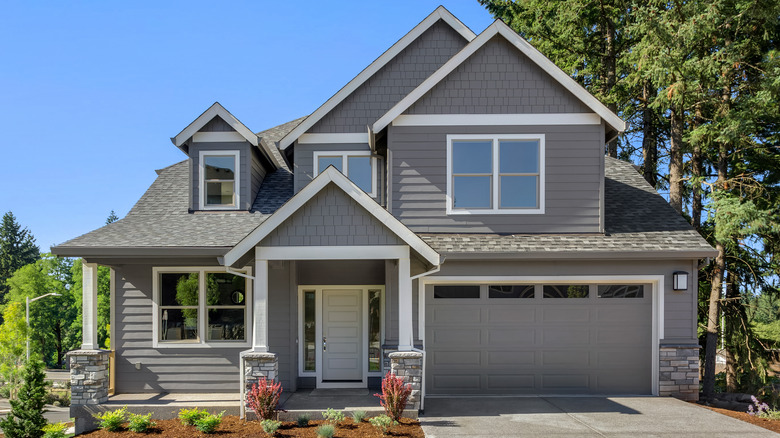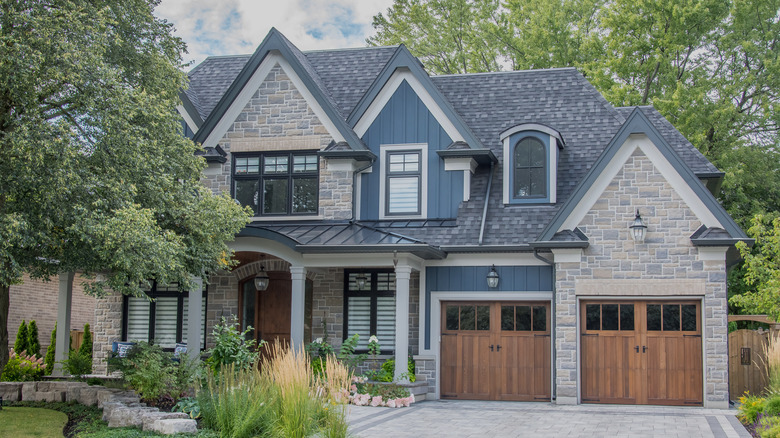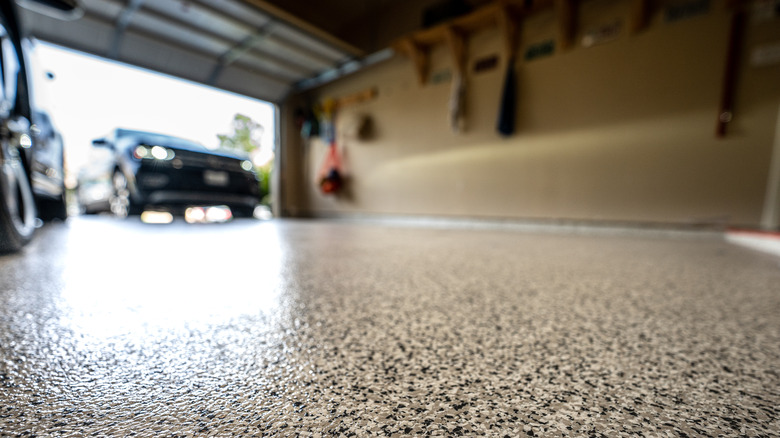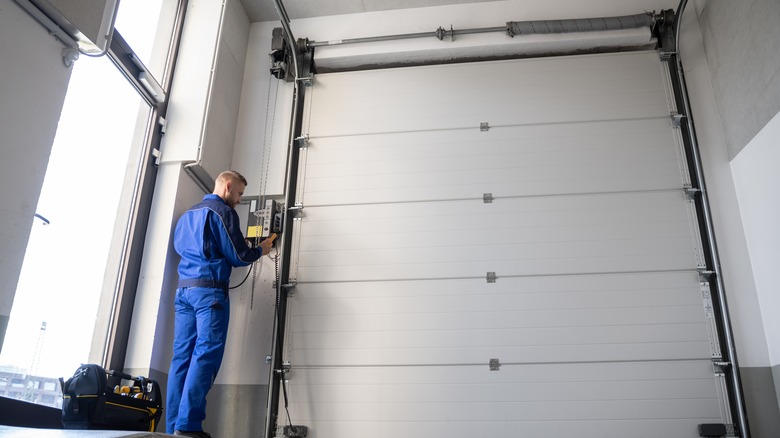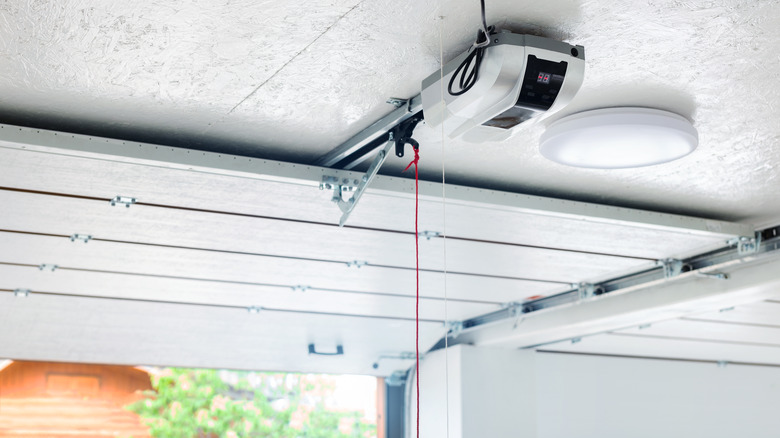5 Tips For Installing Your Own Garage Door Opener
A garage door opener is an important feature for the modern home. It transforms this storage and utility space of your property into a versatile environment that doesn't have to suffer from constant stuffiness and the dim lighting that all too often dominates the garage.
Fortunately, the project of installing a garage door opener is quite simple and can be done by the average homeowner without professional help (via Ron Hazelton). Selecting and installing a garage door opener that works with your particular configuration and the requirements of your home takes a little bit of time and effort though. Installing a high-quality garage door opener that will last for many years and give you access to this key mechanization feature that improves your quality of life is a great choice in just about any home. With these five tips in mind, selecting and installing an opener can be a straightforward process.
Evaluate your current door specifications before purchasing any new materials
The first thing you'll need to do before purchasing a new garage door opener is to take stock of the existing setup that you have in your home's garage space. Garage doors often open through the use of moving panels. These panels are spaced tightly across the surface of your garage door and make use of a half dozen or so. Your garage door might also break into two larger panels, or may include no breaks at all and open as a single sheet. Depending on the way your door opens, you may need to narrow your search for the appropriate opener. Garage Door Specialists report that these doors are installed with different swinging mechanisms to facilitate opening, so selecting a mechanical opener that is compatible will be necessary.
For a modern garage door, the standard layout uses a series of panels that give way as they arrive at the curve. The panels of these doors will break as they get to the top and turn a corner in the track. When fully opened, the garage door will return to a primarily flat orientation, but will be held at a height against the ceiling. The same position will be adopted by any type of garage door, but the physics of bringing the door from the closed position to the open one will differ significantly depending on the number and layout of joints in the overall unit.
Inspect the support system for the door
After you've evaluated the door type and selected an appropriate opening mechanism to support its needs, you'll then need to inspect the support system that holds the door in place when in the open position. Your garage door is made out of aluminum (or perhaps steel) in all likelihood, according to Overhead Door. This makes it a lightweight yet secure installation. However, a garage door can still do severe damage to anything you have stored in the space below if it falls off the track (Ron Hazelton notes that a door can easily weigh 1,000 pounds or more). To install the garage door opener successfully, you'll need to make sure that every component of the opening and closing process continues to perform smoothly. Ostensibly, in order to change the way your door opens, you'll need to change an important feature about how it moves on the track.
To make a door open and close smoothly there is a series of springs, pulleys, and rollers that help maintain tension and allow the door to slide along its path. This system is what makes it possible to lift a heavy garage door by hand. By introducing an automatic door opener, you add a rigid feature to the physics of this movement. As a result, you'll need to make sure that you aren't altering the trajectory or placing added pressure on the door that may eventually cause it to fail.
Consider different types of opening mechanisms
Door openers are generally the same. The technology makes use of a motor and force applicator that pushes the door either forward or backward on the track (via Bennett Science). However, not every door-opening mechanism is created equal. Some garage door openers run nearly silently, and the power of the motor will determine how quickly and smoothly your garage door opens and closes each time you press the button to control its movement.
Homeowners will want to think about their own unique circumstances when selecting an appropriate garage door opener. The homeowner who keeps their car in the garage and leaves on their daily commute early in the morning before anyone else gets up might consider a quieter model, for instance. As with any other amenity in the home, it's important to think about these features and characteristics brought to bear by any new installation. A garage door opener typically incorporates a light as well, but a dim bulb setup might simply contribute to a bleak environment. Comparing models to one another to find the right blend of features is crucial in any installation project, and a garage door opener is no different.
Assemble and install the door opener, then check for odd sounds or visual movement cues
The premise of an automatic door opener is fairly basic. As such, most homeowners won't find any difficulty in following the instructions that come along with their new unit. Assembling each part of the opener and then securing the motor to your ceiling and the arm to the door can typically be done in an afternoon (via Carlisle Garage Door Service). Unless your garage is particularly messy, there isn't much prep work that needs to be done, and basic tools, including a ladder, are all that will be required for this project.
However, it's important to think about the checks that must be done after your installation has been completed. When installing a new door opener, the most important part of the process is the after-action inspection. This is where you'll look for any rough movement as the door slides open and closed along its track. Similarly, listening for any odd sounds that may escape from the process of using the door opener will indicate to you whether the installation has been successful or if it requires some tweaking to get the path of movement locked in just right.
Keep the mechanism lubricated and well-maintained
After installing your garage door opener, you'll want to lubricate the track and any moving parts that facilitate use. Home maintenance projects are often ongoing and a consistent list of features that must be inspected is often par for the course when it comes to the project of homeownership. With a new installation, you may be tempted to leave this asset off your list of maintenance tasks for the time being. But ensuring that you continue performing routine maintenance checks and any work that may be required on the garage door opener is an important part of the installation and continued use of this feature. Angi suggests that a garage door inspection should take place roughly every six months (or at least once per year).
Your garage door opener won't require much in the way of active care, but keeping the moving parts well lubricated comes as a bare minimum for providing longevity and functional use to this addition.
As well, inspecting the garage door opener on a routine basis will give you a better sense of when the unit requires a more thorough look. If it starts making strange sounds or loses power, then it might be worth calling a professional for a second opinion and a fast and effective solution to whatever the problem might be.
